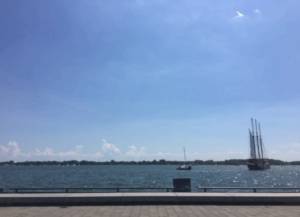Author: Andrew McKenzie (MP3)
This July, I was fortunate to attend the Alzheimer’s Association International Conference (AAIC) in Toronto along with thousands of other attendees. The topics covered at this annual conference range from clinical practice guidelines to neuroimaging, postmortem neuropathology, animal and cellular models of disease, and results of clinical trials. Historically, the conference has focused on the clinical side of Alzheimer’s disease, including the first reports of results from several large clinical trials, and the clinical area retained the lion’s share of presentations this year; however, I was told by veteran attendees that the quantity and proportion of basic science lectures, especially genetics, have dramatically increased over the past several years. Another extremely hot topic at this year’s conference was tau imaging, the signal for which, as predicted from neuropathology data, was generally found to correlate better with memory loss than the imaging signal for amyloid.

A View of Toronto’s Lake Ontario near the 2016 Alzheimer’s Association International Conference (AAIC)
In addition to attending a multitude of informational presentations, I was also given the opportunity to discuss my own work on the functional genetics of oligodendrocytes in Alzheimer’s disease at one of the AAIC symposiums. This was my first oral presentation at an international conference and I was quite nervous about it. I asked a mentor for advice and he assured me that I’d be fine — as long as I practiced my 20-minute talk at least ten times. The night before the presentation, I sat in my hotel room and timed myself as I read the slides over and over again until I fell asleep. The meat of the presentation aside, a key takeaway for me from this experience was how much effort it takes to make an oral scientific presentation look effortless.
I was also able to attend a number of career development events aimed at scientists and clinician-scientists in training. At one of these, we walked through a mock peer review process of an accepted manuscript originally submitted to a journal focusing on Alzheimer’s disease, and we were given pointers on how to make the manuscript submission process more efficient. At another training session, we learned from some of the leaders at the NIH about career development awards and pathways available to aspiring scientists interested in Alzheimer’s disease. One of the other trainees at this event asked whether the many such training programs that have recently been established would be cut due to lack of funding over the coming years. The speaker assured us that the two hardest things to do in government are to get something new started and to get something old stopped, so the training grants were highly likely to continue to be available.
In my anecdotal experience, the vast majority of MD/PhD students at the Icahn School of Medicine at Mt Sinai attend at least one national or international science conference a year. Doing so is obviously a great way to learn about new topics, make scientific contacts and rekindle old ones, and have fun traveling to a new location. What I didn’t expect to learn from attending AAIC is that going to a conference is also a tremendous motivator to work hard on my own lab work. Seeing so many bright clinicians and scientists interested in Alzheimer’s disease helped remind me that although my research can sometimes feel overly detail-oriented and esoteric, it makes a lot more sense contextualized within a broader research community that is exploring a wide variety of possibilities to develop better therapies to treat Alzheimer’s disease.
